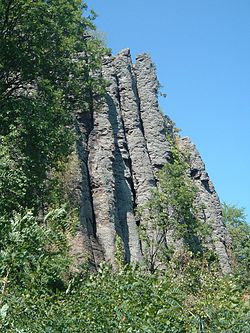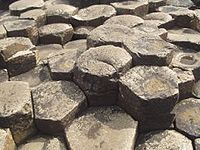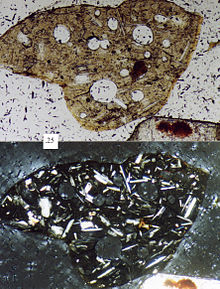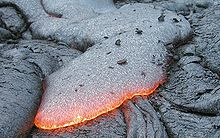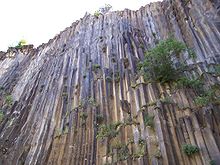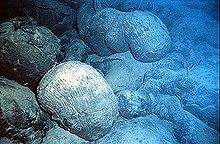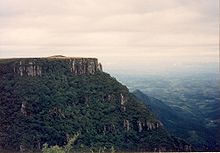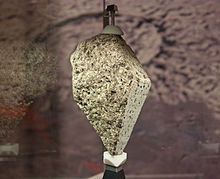- Basalt
-
For the World War II raid, see Operation Basalt. For the cities, see Basalt, Colorado and Basalt, Idaho.
Basalt Igneous Rock 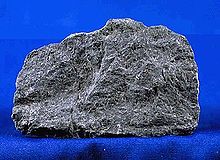
Composition Mafic: amphibole and pyroxene, sometimes plagioclase, feldspathoids, and/or olivine. Basalt (
 /bəˈsɔːlt/, /ˈbæsɔːlt/, or /ˈbeɪsɔːlt/)[1][2] is a common extrusive volcanic rock. It is usually grey to black and fine-grained due to rapid cooling of lava at the surface of a planet. It may be porphyritic containing larger crystals in a fine matrix, or vesicular, or frothy scoria. Unweathered basalt is black or grey. According to the official definition, basalt is defined as an aphanitic igneous rock that contains, by volume, less than 20% quartz and less than 10% feldspathoid and where at least 65% of the feldspar is in the form of plagioclase.
/bəˈsɔːlt/, /ˈbæsɔːlt/, or /ˈbeɪsɔːlt/)[1][2] is a common extrusive volcanic rock. It is usually grey to black and fine-grained due to rapid cooling of lava at the surface of a planet. It may be porphyritic containing larger crystals in a fine matrix, or vesicular, or frothy scoria. Unweathered basalt is black or grey. According to the official definition, basalt is defined as an aphanitic igneous rock that contains, by volume, less than 20% quartz and less than 10% feldspathoid and where at least 65% of the feldspar is in the form of plagioclase.On Earth, most basalt magmas have formed by decompression melting of the mantle. Basalt has also formed on Earth's Moon, Mars, Venus, and even on the asteroid Vesta. Source rocks for the partial melts probably include both peridotite and pyroxenite (e.g., Sobolev et al., 2007). The crustal portions of oceanic tectonic plates are composed predominantly of basalt, produced from upwelling mantle below ocean ridges.
The term basalt is at times applied to shallow intrusive rocks with a composition typical of basalt, but rocks of this composition with a phaneritic (coarse) groundmass are generally referred to as diabase (also called dolerite) or gabbro.
Vesicular basalt at Sunset Crater, Arizona. US quarter for scale.
Contents
Etymology
The word "Basalt" is derived from Late Latin basaltes, misspelling of L. basanites "very hard stone," which was imported from Ancient Greek basani'ty*s (basanites), from ba'sano*s (basanos, "touchstone") and originated in Egyptian bauhun "slate."[3]
Uses
Basalt is used in construction (e.g. as building blocks or in the groundwork), making cobblestones (from columnar basalt) and in making statues. Heating and extruding basalt yields stone wool, an excellent thermal insulator.
Types
- Tholeiitic basalt is relatively rich in silica and poor in sodium. Included in this category are most basalts of the ocean floor, most large oceanic islands, and continental flood basalts such as the Columbia River Plateau.
- MORB (Mid Ocean Ridge Basalt), is characteristically low in incompatible elements. MORB is commonly erupted only at ocean ridges. MORB itself has been subdivided into varieties such as NMORB and EMORB (slightly more enriched in incompatible elements).[4][5]
- High alumina basalt may be silica-undersaturated or -oversaturated (see normative mineralogy). It has greater than 17% alumina (Al2O3) and is intermediate in composition between tholeiite and alkali basalt; the relatively alumina-rich composition is based on rocks without phenocrysts of plagioclase.
- Alkali basalt is relatively poor in silica and rich in sodium. It is silica-undersaturated and may contain feldspathoids, alkali feldspar and phlogopite.
- Boninite is a high-magnesium form of basalt that is erupted generally in back-arc basins, distinguished by its low titanium content and trace element composition.
Petrology
The mineralogy of basalt is characterized by a preponderance of calcic plagioclase feldspar and pyroxene. Olivine can also be a significant constituent. Accessory minerals present in relatively minor amounts include iron oxides and iron-titanium oxides, such as magnetite, ulvospinel, and ilmenite. Because of the presence of such oxide minerals, basalt can acquire strong magnetic signatures as it cools, and paleomagnetic studies have made extensive use of basalt.
In tholeiitic basalt, pyroxene (augite and orthopyroxene or pigeonite) and calcium-rich plagioclase are common phenocryst minerals. Olivine may also be a phenocryst, and when present, may have rims of pigeonite. The groundmass contains interstitial quartz or tridymite or cristobalite. Olivine tholeiite has augite and orthopyroxene or pigeonite with abundant olivine, but olivine may have rims of pyroxene and is unlikely to be present in the groundmass.
Alkali basalts typically have mineral assemblages that lack orthopyroxene but contain olivine. Feldspar phenocrysts typically are labradorite to andesine in composition. Augite is rich in titanium compared to augite in tholeiitic basalt. Minerals such as alkali feldspar, leucite, nepheline, sodalite, phlogopite mica, and apatite may be present in the groundmass.
Basalt has high liquidus and solidus temperatures--values at the Earth's surface are near or above 1200 °C (liquidus) and near or below 1000 °C (solidus); these values are higher than those of other common igneous rocks.
The majority of tholeiites are formed at approximately 50-100 km depth within the mantle. Many alkali basalts may be formed at greater depths, perhaps as deep as 150-200 km. The origin of high-alumina basalt continues to be controversial, with interpretations that it is a primary melt and that instead it is derived from other basalt types (e.g., Ozerov, 2000).
Geochemistry
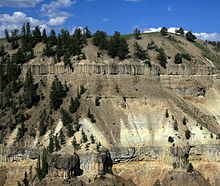 Columnar basalt flows in Yellowstone National Park, USA.
Columnar basalt flows in Yellowstone National Park, USA.
Relative to most common igneous rocks, basalt compositions are rich in MgO and CaO and low in SiO2 and the alkali oxides, i.e., Na2O + K2O, consistent with the TAS classification.
Basalt generally has a composition of 45-55 wt% SiO2, 2-6 wt% total alkalis, 0.5-2.0 wt% TiO2, 5-14 wt% FeO and 14 wt% or more Al2O3. Contents of CaO are commonly near 10 wt%, those of MgO commonly in the range 5 to 12 wt%.
High alumina basalts have aluminium contents of 17-19 wt% Al2O3; boninites have magnesium contents of up to 15% MgO. Rare feldspathoid-rich mafic rocks, akin to alkali basalts, may have Na2O + K2O contents of 12% or more.
MORB basalts and their intrusive equivalents, gabbros, are the characteristic igneous rocks formed at mid-ocean ridges. They are tholeiites particularly low in total alkalis and in incompatible trace elements, and they have relatively flat REE patterns normalized to mantle or chondrite values. In contrast, alkali basalts have normalized patterns highly enriched in the light REE, and with greater abundances of the REE and of other incompatible elements. Because MORB basalt is considered a key to understanding plate tectonics, its compositions have been much studied. Although MORB compositions are distinctive relative to average compositions of basalts erupted in other environments, they are not uniform. For instance, compositions change with position along the Mid-Atlantic ridge, and the compositions also define different ranges in different ocean basins (Hofmann, 2003).
Isotope ratios of elements such as strontium, neodymium, lead, hafnium, and osmium in basalts have been much-studied, so as to learn about evolution of the Earth's mantle. Isotopic ratios of noble gases, such as 3He/4He, are also of great value: for instance, ratios for basalts range from 6 to 10 for mid-ocean ridge tholeiite (normalized to atmospheric values), but to 15-24+ for ocean island basalts thought to be derived from mantle plumes.
Morphology and textures
The shape, structure and texture of a basalt is diagnostic of how and where it erupted -- whether into the sea, in an explosive cinder eruption or as creeping pahoehoe lava flows, the classic image of Hawaiian basalt eruptions.
Subaerial eruptions
Basalt which erupts under open air (that is, subaerially) forms three distinct types of lava or volcanic deposits: scoria; ash or cinder (breccia); and lava flows.
Basalt in the tops of subaerial lava flows and cinder cones will often be highly vesiculated, imparting a lightweight "frothy" texture to the rock. Basaltic cinders are often red, coloured by oxidized iron from weathered iron-rich minerals such as pyroxene.
`A`a types of blocky, cinder and breccia flows of thick, viscous basaltic lava are common in Hawaii. Pahoehoe is a highly fluid, hot form of basalt which tends to form thin aprons of molten lava which fill up hollows and sometimes forms lava lakes. Lava tubes are common features of pahoehoe eruptions.
Basaltic tuff or pyroclastic rocks are rare but not unknown. Usually basalt is too hot and fluid to build up sufficient pressure to form explosive lava eruptions but occasionally this will happen by trapping of the lava within the volcanic throat and build up of volcanic gases. Hawaii's Mauna Loa volcano erupted in this way in the 19th century, as did Mount Tarawera, New Zealand in its violent 1886 eruption. Maar volcanoes are typical of small basalt tuffs, formed by explosive eruption of basalt through the crust, forming an apron of mixed basalt and wall rock breccia and a fan of basalt tuff further out from the volcano.
Amygdaloidal structure is common in relict vesicles and beautifully crystallized species of zeolites, quartz or calcite are frequently found.
Columnar basalt
During the cooling of a thick lava flow, contractional joints or fractures form. If a flow cools relatively rapidly, significant contraction forces build up. While a flow can shrink in the vertical dimension without fracturing, it cannot easily accommodate shrinking in the horizontal direction unless cracks form; the extensive fracture network that develops results in the formation of columns. The topology of the lateral shapes of these columns can broadly be classed as a random cellular network. These structures are often erroneously described as being predominantly hexagonal. In reality, the mean number of sides of all the columns in such a structure is indeed six (by geometrical definition), but polygons with three to twelve or more sides can be observed.[6] Note that the size of the columns depends loosely on the rate of cooling; very rapid cooling may result in very small (<1 cm diameter) columns, while slow cooling is more likely to produce large columns.
See also: List of places with columnar basaltSubmarine eruptions
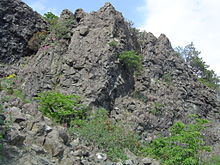 Outcrop of a Pillow Basalt, Italy
Outcrop of a Pillow Basalt, Italy
Pillow basalts
When basalt erupts underwater or flows into the sea, contact with the water quenches the surface and the lava forms a distinctive pillow shape, through which the hot lava breaks to form another pillow. This pillow texture is very common in underwater basaltic flows and is diagnostic of an underwater eruption environment when found in ancient rocks. Pillows typically consist of a fine-grained core with a glassy crust and have radial jointing. The size of individual pillows varies from 10 cm up to several meters.
When pahoehoe lava enters the sea it usually forms pillow basalts. However when a'a enters the ocean it forms a littoral cone, a small cone-shaped accumulation of tuffaceous debris formed when the blocky a'a lava enters the water and explodes from built-up steam.
The island of Surtsey in the Atlantic Ocean is a basalt volcano which breached the ocean surface in 1963. The initial phase of Surtsey's eruption was highly explosive, as the magma was quite wet, causing the rock to be blown apart by the boiling steam to form a tuff and cinder cone. This has subsequently moved to a typical pahoehoe type behaviour.
Volcanic glass may be present, particularly as rinds on rapidly chilled surfaces of lava flows, and is commonly (but not exclusively) associated with underwater eruptions.
Life on basaltic rocks
The common corrosion features of underwater volcanic basalt suggest that microbial activity may play a significant role in the chemical exchange between basaltic rocks and seawater. The significant amounts of reduced iron, Fe(II), and manganese, Mn(II), present in basaltic rocks provide potential energy sources for bacteria. Recent research has shown that some Fe(II)-oxidizing bacteria cultured from iron-sulfide surfaces are also able to grow with basaltic rock as a source of Fe(II).[7] In recent work at Loihi Seamount, Fe- and Mn- oxidizing bacteria have been cultured from weathered basalts.[8] The impact of bacteria on altering the chemical composition of basaltic glass (and thus, the oceanic crust) and seawater suggest that these interactions may lead to an application of hydrothermal vents to the origin of life.
Distribution
Paraná Traps, Brazil
Basalt is one of the most common rock types in the world. Basalt is the rock most typical of large igneous provinces. The largest occurrences of basalt are in the ocean floor that is almost completely made up by basalt. Above sea level basalt is common in hotspot islands and around volcanic arcs, specially those on thin crust. However, the largest volumes of basalt on land correspond to continental flood basalts. Continental flood basalts are known to exist in the Deccan Traps in India, the Chilcotin Group in British Columbia, Canada, the Paraná Traps in Brazil, the Siberian Traps in Russia, the Karoo flood basalt province in South Africa, the Columbia River Plateau of Washington and Oregon.
Many archipelagoes and island nations have an overwhelming majority of its exposed bedrock made up by basalt due to being above hotspots, for example, Iceland and Hawaii
Ancient Precambrian basalts are usually only found in fold and thrust belts, and are often heavily metamorphosed. These are known as greenstone belts, because low-grade metamorphism of basalt produces chlorite, actinolite, epidote and other green minerals.
Lunar and Martian basalt
The dark areas visible on Earth's moon, the lunar maria, are plains of flood basaltic lava flows. These rocks were sampled by the manned American Apollo program, the robotic Russian Luna program, and are represented among the lunar meteorites.
Lunar basalts differ from their terrestrial counterparts principally in their high iron contents, which typically range from about 17 to 22 wt% FeO. They also possess a stunning range of titanium concentrations (present in the mineral ilmenite), ranging from less than 1 wt% TiO2, to about 13 wt.%. Traditionally, lunar basalts have been classified according to their titanium content, with classes being named high-Ti, low-Ti, and very-low-Ti. Nevertheless, global geochemical maps of titanium obtained from the Clementine mission demonstrate that the lunar maria possesses a continuum of titanium concentrations, and that the highest concentrations are the least abundant.
Lunar basalts show exotic textures and mineralogy, particularly shock metamorphism, lack of the oxidation typical of terrestrial basalts, and a complete lack of hydration. While most of the Moon's basalts erupted between about 3 and 3.5 billion years ago, the oldest samples are 4.2 billion years old, and the youngest flows, based on the age dating method of "crater counting," are estimated to have erupted only 1.2 billion years ago.
Basalt is also a common rock on the surface of Mars, as determined by data sent back from the planet's surface and by Martian meteorites.
Alteration of basalt
Metamorphism
Basalts are important rocks within metamorphic belts, as they can provide vital information on the conditions of metamorphism within the belt. Various metamorphic facies are named after the mineral assemblages and rock types formed by subjecting basalts to the temperatures and pressures of the metamorphic event. These are:
- Blueschist facies
- Eclogite facies
- Granulite facies
- Greenschist facies
- Zeolite facies
Metamorphosed basalts are important hosts for a variety of hydrothermal ore deposits, including gold deposits, copper deposits, volcanogenic massive sulfide ore deposits and others.
Weathering
Compared to other rocks found on Earth's surface, basalts weather relatively fast. Chemical weathering of basalt minerals release cations such as calcium, sodium and magnesium, which give basaltic areas a strong buffer capacity against acidification. Calcium released by basalts binds up CO2 from the atmosphere forming CaCO3 acting thus as a CO2 trap. To this it must be added that the eruption of basalt itself is often associated with the release of large quantities of CO2 into the atmosphere from volcanic gases.
Carbon sequestration in basalt has been studied as a means of removing carbon dioxide, produced by human industrialization, from the atmosphere. Underwater basalt deposits, scattered in seas around the globe, have the added benefit of the water serving as a barrier to the re-release of CO2 into the atmosphere.[9]
See also
- Basalt fiber
- Flood basalt
- Igneous rocks
- Mafic rocks
- Volcanoes
References
- ^ basalt definition - Dictionary - MSN Encarta. Archived 2009-10-31.
- ^ Yourdictionary.com
- ^ Etymonline.com
- ^ See the PETDB database.Hyndman, Donald W. (1985). Petrology of igneous and metamorphic rocks (2nd ed. ed.). McGraw-Hill. ISBN 0-07-031658-9.
- ^ Blatt, Harvey and Robert Tracy (1996). Petrology (2nd ed. ed.). Freeman. ISBN 0-7167-2438-3.
- ^ D. Weaire and N. Rivier. Contemporary Physics 25 1 (1984), pp. 55-99
- ^ Katrina J. Edwards, Wolfgang Bach and Daniel R. Rogers, Geomicrobiology of the Ocean Crust: A Role for Chemoautotrophic Fe-Bacteria, Biol. Bull. 204: 180-185. (April 2003) Biolbull.org
- ^ Templeton, A.S., Staudigel, H., Tebo, B.M. (2005). Diverse Mn(II)-oxidizing bacteria isolated from submarine basalts at Loihi Seamount, Geomicrobiology Journal, v. 22, 129-137. OGI.edu
- ^ Mongabay.com
- A. Y. Ozerov, The evolution of high-alumina basalts of the Klyuchevskoy volcano, Kamchatka, Russia, based on microprobe analyses of mineral inclusions. Journal of Volcanology and Geothermal Research, v. 95, pp. 65-79 (2000).
- A. W. Hofmann, Sampling mantle heterogeneity through oceanic basalts: isotopes and trace elements. Treatise on Geochemistry Volume 2, pages 61-101 Elsevier Ltd. (2003). ISBN 0-08-044337-0 In March, 2007, the article was available on the web at MPG.de.
- A. V. Sobolev and others, The amount of recycled crust in sources of mantle-derived melts. Science, v. 316, pp. 412-417 (2007). Sciencemag.org
- Ablesimov N.E., Zemtsov A.N. Relaxation effects in non-equilibrium condense systems. Basalts : from eruption up to a fiber. Moskow: ITiG FEB RAS, 2010. 400 p.
External links
- Basalt Columns
- Basalt in Northern Ireland
- Lava - water interface
- Petrology of Lunar Rocks and Mare Basalts
- Pillow lava USGS[dead link]
Igneous rocks by composition Type Ultramafic
< 45% SiO2Mafic
45-52% SiO2Intermediate
52–63% SiO2Intermediate-Felsic
63–69% SiO2Felsic
>69 % SiO2Volcanic rocks:
Subvolcanic rocks:
Plutonic rocks:Basalt
Diabase (Dolerite)
GabbroTypes of basalts Basalts by tectonic setting Basalts by form and flow Basalts by chemistry Tholeiitic basalt · Calc-alkaline basalt · Alkali basalt · Basaltic andesite · Trachybasalt · Hawaiite · Mugearite · PicriteImportant minerals Olivine · Pyroxene · Plagioclase · Amphibole · Magnetite · Ilmenite · Quartz · Cristobalite · TrydimiteCategories:- Basalt
- Volcanic rocks
Wikimedia Foundation. 2010.

